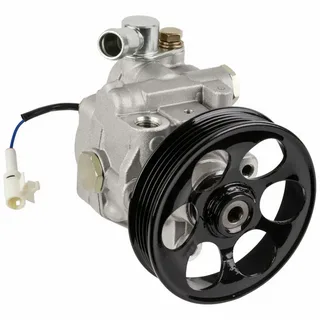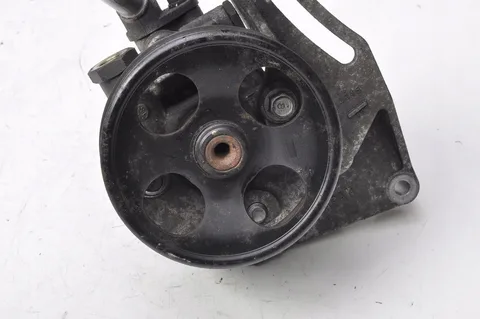Have you ever wondered what keeps your Subaru Forester gliding smoothly around tight corners and quickly navigating tricky parking lots? Enter the unsung hero of your driving experience: the power steering pump. This vital component ensures that every turn is effortless, allowing you to focus on the road ahead rather than wrestling with your steering wheel. In this blog post, we’ll dive into the intricate mechanics of the Forester power steering pump, demystifying its role in enhancing vehicle maneuverability.
What is the Purpose of a Power Steering Pump?
The power steering pump plays a crucial role in the functioning of your Forester’s power steering system. Its primary purpose is to assist the driver in turning the vehicle’s wheels quickly and precisely, especially at low speeds or when maneuvering sharp turns. Without it, driving a car would require significantly more effort and strength from the driver.
The power steering pump provides hydraulic pressure to the power steering system, which helps reduce the amount of force needed by the driver to turn the wheels. This is achieved through a series of intricate mechanics that work together seamlessly.
Inside the pump are two main components: a rotor and vanes. The rotor is connected to an engine belt, causing it to spin as soon as it starts running. As it rotates, it creates suction in its gaps, drawing hydraulic fluid into those empty spaces.
Once inside, centrifugal force pushes these fluids towards outlet ports on either side of the rotor. The fluids then reach vanes, which serve as small valves that regulate where they flow next.
At this point, any fluid that goes out through one port results in another equal amount being forced into another outlet port on top (or “degree”) away from where they came out on at 180 degrees apart rotation).
How Does the Power Steering Pump Work?
Understanding the mechanics of your Forester’s power steering pump is crucial for maintaining its optimal functionality. This component is vital in helping you turn the steering wheel and ensure a smooth driving experience.
So, how exactly does the power steering pump work? Let’s break it down into four main steps:
1. Power from the engine
The power steering pump is typically driven by a belt that connects to the engine. As you start your car, the engine begins to rotate, and this rotation also drives the pump.
2. Hydraulic system
Inside the power steering pump, there is a hydraulic system consisting of a rotor and vanes. These vanes draw fluid from the reservoir and send it to various components in the vehicle’s power steering system.
3. Pressurized fluid
As the rotors spin, they create a suction that pulls power steering fluid from the reservoir into one side of the pump. The rotating motion then compresses this fluid, increasing its pressure before pushing it through another passage into your vehicle’s steering gearbox or rack.
4. Assisting with steering
Once pressurised fluid reaches your car’s gear mechanism, it helps amplify any force applied to your steering wheel, making it easier to turn it while driving.
Signs of a Failing Power Steering Pump
When it comes to maintaining your Forester’s power steering system, one of the most critical components to watch is the power steering pump. This pump is responsible for pressurising and circulating power steering fluid throughout the system, making it crucial in providing effortless steering control.
Over time, this essential component can show wear and tear, eventually leading to a failing power steering pump. It is necessary to recognise these signs early on so that you can address any potential issues before they escalate into more significant problems.
Here are some common signs that your Forester’s power steering pump may be failing:
1. Whining or Grinding Noises:
Hearing high-pitched whining or grinding noises when turning the wheel could indicate a problem with your power steering pump. These sounds are usually caused by air bubbles in the fluid or metal-to-metal contact within the pump.
2. Difficulty Steering:
A failing power steering pump can make steering your vehicle difficult, especially at low speeds. If you feel like the wheel has become stiff or unresponsive, this could mean the pump is failing.
3. Leaking Fluid:
The power steering system relies on a consistent fluid level to operate correctly. If you notice any puddles of reddish-brown fluid underneath your vehicle when parked or dark spots under the hood, it could be a sign that your pump is leaking and needs attention.
4. Jerky Wheel Movements:
If you experience jerky movements rather than smooth ones when turning the wheel, this may indicate a lack of pressure from the power steering pump due to malfunction or clogging.
Maintenance Tips for a Healthy Power Steering System
Power steering is an essential component of a car, as it allows the driver to steer easily and provides better road control. The power steering system consists of various parts, but the power steering pump is the most important. This pump is responsible for providing hydraulic pressure to assist with steering.
To ensure that your power steering system remains in top condition and functions smoothly, here are some maintenance tips you should follow:
1. Regularly check the power steering fluid levels:
The power steering fluid acts as a lubricant and helps keep the components cool. Monitoring the fluid level and topping it up if it falls below the recommended mark is vital. Be sure to use only manufacturer-recommended fluids, as different types may cause damage to your vehicle’s power steering system.
2. Inspect for any leaks:
Leaks in the power steering system can lead to low fluid levels or even complete failure of the pump if left unchecked. Look for any puddles under your car, especially after extended drives or when turning at low speeds. If you notice any leaks, get them repaired immediately by a professional mechanic.
3. Replace worn-out belts:
The belt that connects the engine to the power steering pump can wear out over time due to constant movement and exposure to extreme temperatures. A damaged belt can cause issues with the smooth operation of your car’s power steering system, leading to difficulty while turning or loss of assistance altogether.
 Upgrading Your Power Steering Pump
Upgrading Your Power Steering Pump
While the power steering pump in your Forester is designed to last for a long time, there may come a time when you need to upgrade it. This could be due to wear and tear over time or if you want improved performance from your vehicle’s power steering system.
Before upgrading your power steering pump, it’s important to understand what type your Forester currently has. There are two main types of power steering pumps: hydraulic and electric. Hydraulic pumps use fluid pressure generated by an engine-driven belt to assist with steering, while electric pumps use an electrical motor.
There are a few upgrade options if your Forester has a hydraulic power steering pump. One option is replacing the entire pump with a newer model with better performance capabilities. Another option is to install a high-performance pulley kit onto your existing pump. This will increase the pressure and flow within the system, providing more assistance and smoother steering.
A few options are also available when upgrading an electric power steering pump. You can opt for an upgraded version of your current pump with enhanced features such as increased torque output or faster response time. Alternatively, you can switch from an electric pump back to a hydraulic one if you prefer the feel and response of traditional hydraulic systems.
Replacing the Power Steering Pump
One of the most common issues with a Forester’s power steering system is a malfunctioning power steering pump. This essential component provides the necessary pressure to turn the wheels smoothly and easily, so it’s crucial to address any problems with it promptly.
When do you know it’s time to replace your power steering pump? Some signs that indicate your pump needs replacing include difficulty turning the wheel, noticeable noise when turning, or visible leaks under the car. If you are experiencing any of these symptoms, getting your vehicle inspected by a trusted mechanic as soon as possible is essential.
Replacing a power steering pump involves removing and installing a new one. But before diving into the replacement procedure, you must take several necessary steps.
Firstly, ensure you have all the necessary tools and familiarise yourself with their proper use. Having an assistant available for assistance during specific steps would also be helpful.
Next, locate and access the power steering pump in your Forester. The exact location may vary depending on your vehicle’s model year; however, it can usually be found at the front of the engine bay near where the serpentine belt is located.
Once you have located the pump, begin by draining out all old fluid from both reservoirs – one for topping up and another marked low-line or emptying. Afterwards, tension from any accessory belts attached to the pulleys on or around this component is released before being disconnected entirely.
With everything detached and tightened screws holding together parts removed (some models may require using special tools), remove bolts, then pull this critical part gently towards yourself slowly until reaching its final position – being careful not to tear anything gasket-related during removal if applicable since repairing gaskets costs even more money than buying another affordable used part which can usually fix a problem caused due excessive wear.
Once the old power steering pump is removed, it’s time to install the new one. Be sure to transfer gaskets or seals from the old pump to the new one and carefully align the mounting holes. Then, reattach all bolts and attach accessory belts to their respective pulleys.
Refill both reservoirs with fresh power steering fluid and start your Forester. Turn the wheel several times to bleed out any air that may have entered during installation. If everything is fine, you’ve successfully replaced your Forester’s power steering pump!
Conclusion
In conclusion, the Forester power steering pump is a crucial component of your car’s steering system that helps to make driving more accessible and comfortable. By understanding its mechanics and signs of potential issues, you can save yourself from costly repairs and ensure the safety of your vehicle. Regular maintenance and addressing problems promptly are vital to keeping your Forester’s power steering pump in good condition. Remember to consult a professional mechanic for any major concerns or replacements. With this knowledge, you can confidently navigate the road ahead with a well-functioning power steering pump.
FAQS
2. How does a Forester power steering pump work?
The Forester power steering pump uses engine power to drive a belt, which then turns a rotor inside the pump. The rotating rotor creates pressure that pushes fluid through hoses and into the power steering gear, allowing for easier wheel movement.
3. What are the common symptoms of a failing power steering pump?
Common signs of a failing power steering pump include difficulty turning the wheel, whining or groaning noises when turning, leaking fluid, and increased effort needed to steer.
4. How long do power steering pumps typically last?
Power steering pumps can last anywhere from 70,000 to 100,000 miles, depending on usage and maintenance. However, if there is an underlying issue with another component in the system, it can cause premature failure of the pump.
| Other Good Articles to Read |
| Skank Blogs |
| Unreal Blogs |
| Tba Blogs |
| All City Forums |
| Dany Blogs |
| Refuge Blogs |
| The Music Blogs |
| Key Forums |
| The Big Blog Theory |
| Joe Blogs |
| Blogs 4 Me |
| Blogs Emon |
| Related Business Listings |
| Contact Directory |
| Local Business Profiles |



